|
1.
CENTRAL/ WEST AFRICA
Buying patterns in Europe drive prices higher
In the second half of November, prices rose for some species, particularly due to changing buying
patterns in Europe. These are very much demand-led and respond to resumed interest and selective
buying from Europe. Afromosia, azobe, douka and sapele showed notable gains and increased
demand for belli by buyers from India pushed prices for the species higher. Sipo prices for LM
and B grades continued stable at the recent higher levels while the BC/C grade moved higher with
increased demand from both Europe and the Far East. Europe¡¯s renewed interest in iroko moved
prices up and the species now competes at the same price as that for Far East
destinations.
Demand for moabi slowed and prices moved downward in spite of fair demand from French buyers.
Okan prices for European buyers also moved lower, although prices for Chinese buyers were
unchanged even though demand was low. Heavy rains in some areas were also continuing to
affect logging and transport operations.
For sawnwood, recently higher log prices and reduced supply from Northern Congo and Central
African Republic may cause sapele lumber prices to rise. Outside of sapele, there were no other
anticipated reports of large fluctuations in sawnwood prices.
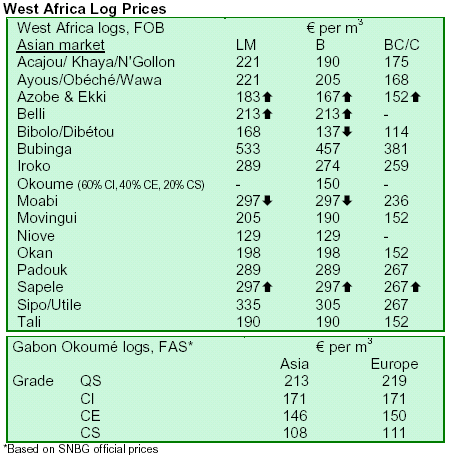
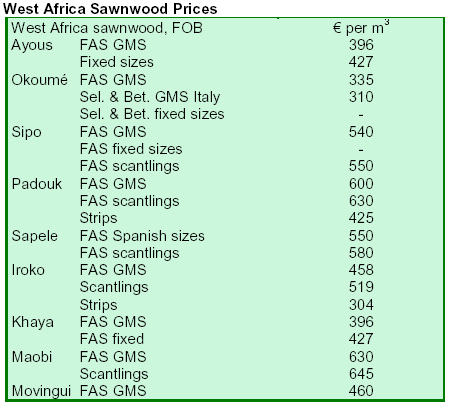
2. GHANA
Ghana¡¯s 2008 budget provides for massive
infrastructure investments
The Minister for Finance and Economic Planning introduced the 2008 Budget Statement and
Economic Policy on 15 November 2007. The government indicated there had been significant
improvement in the socioeconomic landscape of the country over the past seven
years. He said this should give cause for continued optimism for Ghana to attain Middle Income Status by
2015. Also, Ghana¡¯s improvement in its international economic ratings is a clear testimony to its continued
quest to improve living standards in the country.
Among the budget¡¯s highlights were a proposed total government revenue estimated at GH¡é7.1
billion; gross domestic product is targeted at 7%; and end of year inflation is targeted between 6%
and 8%. According to the Minister, the budget will promote growth through massive
infrastructure development, including through roads, water and energy development. The government will fund 166
districts to construct and tar 15kms in each district over the course of the year at a projected
amount of approximately GH¡é199 million. Five communities in each of the 166 districts will be
provided with potable drinking water. The estimated amount for the potable water project
alone is GH¡é7 million.
Ghana¡¯s timber and forest resources hold future promise for economy
Recent developments in Ghana¡¯s timber and forest sector were announced during the 2008 Budget
Statement. It was noted that timber exports had remained flat and were expected to reach
approximately GH¡é241 million by the end of the year.
With regard to the Voluntary Partnership Agreement (VPA) with the EU, negotiations are expected
to conclude by mid-2008. Other activities to be pursued with the EU include the integration of a
log-tracking system into the Validation of Legal Timber Programme (VLTP) and the
commencement of the Natural Resource and Environmental Governance (NREG) Programme. As a
result of these activities, Ghana is expected to be in a better position to enforce forest laws, which will
contribute to securing forest revenue for the country.
Additionally, a new programme to promote traditional medicine was announced. The programme will
help emerging industries using herbs for alcohol-based medicine set up first aid gardens and
medicinal farms to ease pressure on the forest.
Finally, the National Disaster Management Organization (NADMO) is expected to train and equip
Disaster Volunteer Groups (DVGs) in forest protection management and plant five million seedlings
of various species to ensure the restoration of degraded natural forests.
Ghana¡¯s development partners boost aid
Ghana¡¯s development partners have announced they will provide USD350 million, or 9-13% of the
total government¡¯s budget, to bolster Ghana¡¯s chances of reaching the Millennium Development
Goals and becoming a Middle Income Country by 2015. Since 2003, development partners have
contributed around USD 300 million each year to the general budget in the form on
loans and grants. Ghana¡¯s development partners include the World Bank, the African Development Bank,
Canada, Denmark, the European Commission, France, Germany, the Netherlands, Switzerland, the
UK and Japan.
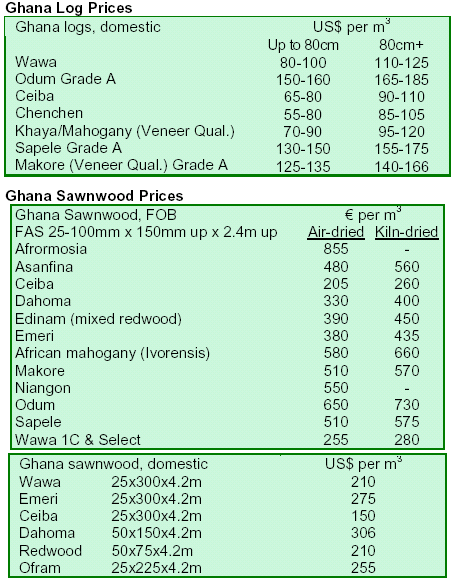
3.
MALAYSIA
Monsoon season halts price rise
The annual monsoon season failed to lift prices of Malaysian timber products. The Malaysian timber
industry saw prices fall sharply on a broad front, particularly for raw logs and plywood. This
compounded the problems faced by the industry, which has already been hit by the
meltdown in the US subprime mortgage market.
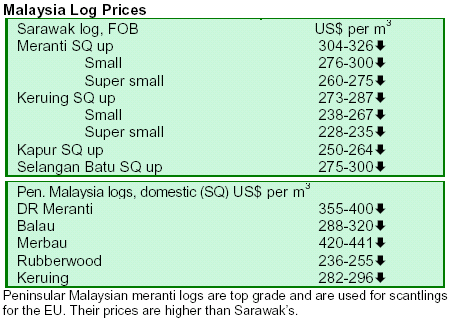
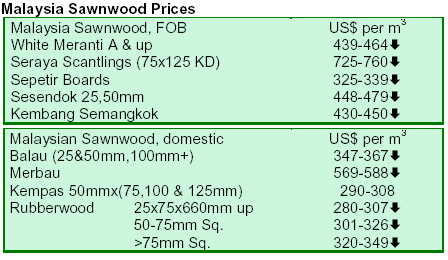
4.
INDONESIA
Government prepares to unveil global warming action plan
As reported in The Jakarta Post, the Indonesian government will soon unveil its national action plan
(RAN) to address global warming. The plan is expected to set guidelines that will assist Indonesia
in mitigating and adapting to climate change. The Indonesian Environment Ministry has said that
the plan includes a development strategy focused on alleviating poverty, creating jobs and
economic growth, and improving the environment. The plan will help preserve forests and address carbon
sequestration to reduce carbon emissions by up to 30% by the year 2025.
Fearing they may be neglected in the coordination process for the strategy, the Indonesian
Chamber of Commerce and Industry (Kadin) has called for a comprehensive approach to address
the issues of environment and industry in the new strategy. Kadin had appointed a team
of 15 industry leaders to help draft the plan, which is expected to be made public at the upcoming UN
Framework Convention on Climate Change (UNFCCC). Others speaking to the Environment Ministry
on the subject, such as the CEO of Sinar Mas Agribusiness and Food, said the government needed
to address land allocation matters in the new strategy to avoid future disputes.
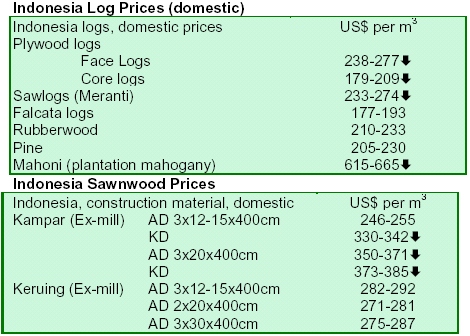
5.
MYANMAR
Myanmar sanctioned by EU
The EU agreed to a Council Common Position, which forbids the exportation of machinery for or
investments in Myanmar companies engaged in timber processing and export. European countries
will also be prevented from importing logs, timber and timber products from such
companies. TTJ Online reported that the EU Council agreed to the measures after meeting in Luxembourg,
where ministers stressed the ¡®seriousness¡¯ of the situation in Myanmar.
Prices for the higher grades in this month¡¯s tender sales rose, while prices for lower grades of teak
were subdued. There was a substantial drop in supply of SG-3 logs, although the production and
total traded volume for SG-3 is on the whole not significant. Seven lots of SG-7 grades
obtained lower prices than those for SG-8 grades. Nevertheless, this anomaly is not uncommon as prices for
the lower grades have not followed a clear pattern. The average price obtained for export quality
pyinkado is within range of the list price (USD470-500). The non-teak hardwood market also seems
to be moving at its own pace, and not dependent on changes in seasonal demand.
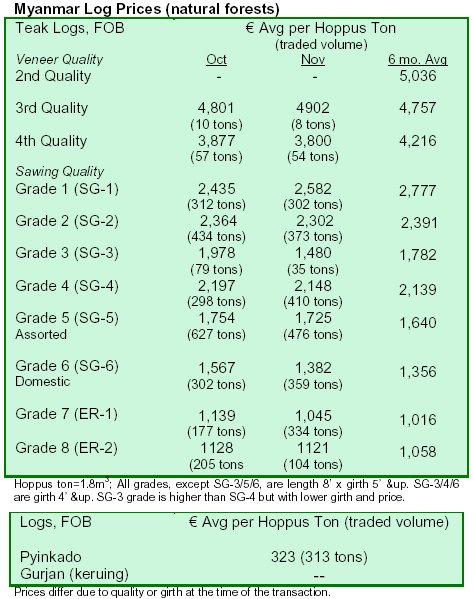
6.
BRAZIL
Brazil postpones timber concession bidding
Meio Ambiente reported that on 14 November, the Ministry of Environment opened the bidding
process for forest concessions in the National Forest of Jamari in Northern Brazil (state of
Rondonia). However, the selection process has been postponed to take into consideration public
suggestions on the bidding process. During a recent public hearing on the subject, one
participant suggested that the list of non-timber forest products (NTFPs) for use by communities should be
expanded to include NTFPs such as copaiba oil, breu resin, and palm fruits and that
concessionaires should allow communities to harvest these products. Others suggested revising
social and environmental criteria for the bidding process.
The first lot of the concessions to be contracted will be 96,000 ha and divided into three forest
management units, which can be used for a variety of purposes. In addition to
using the concessions for harvesting timber or conservation purposes, the concessionaires can also offer
ecotourism and sports recreation in the forest. Each management unit will be leased for 40 years
and the Brazilian Forest Service expects that contracts will be signed by March.
Mato Grosso¡¯s plan on avoided deforestation to be launched at COP-13
S¨® Not¨ªcias said that the state of Mato Grosso will present its plan on avoided deforestation at the
UN Framework Convention on Climate Change¡¯s 13th Conference of the Parties (COP-13), which
will be held in Bali, Indonesia, from 3-14 December 2007. The state is currently
considering a range of global warming funds and the renegotiation of state and/or private debts as possibilities
for compensation to those producers who participate in avoided deforestation schemes.
Two key mechanisms will help track progress on the implementation of the plan. One mechanism
is Environmental Licensing in Rural Properties (SLAPR), which can detect illegal deforestation
within properties with proper licenses through satellite images and field inspections. The other
mechanism is the Integrated System of Monitoring and Environmental Licensing
(SIMLAMMT). The technologies will help guarantee transparency of actions undertaken in the plan and ensure
payment to those who conserve the forests.
Teak plantations show promise for Northern Brazil
Teak has shown to be a promising species for conditions in Northern Brazil, noted Ambiente
Brasil. When parts of the Amazon were being reforested, exotic teak species were planted in Northern
Brazil alongside other native species such as mahogany and cedar. However, high
mortality rates were seen for many of the native species, which were affected by disease and pests and the
species¡¯ inability to adapt to conditions in the region.
Acre provided ideal conditions for teak in the Upper and Lower Rio areas. In other areas of the state,
teak grew well but did not produce high quality wood. Due to its success in Acre, teak is seen by
many Brazilians as an increasingly attractive investment. Teak is now perceived as a tool for
¡®green social welfare¡¯ and an opportunity for landowners to manage assets on their land.
Exports of wood products rise 13% in October
Exports of wood products in October 2007 generally showed growth from October 2006 levels.
Exports of general wood products (except pulp and paper) rose from USD332.5 million in October
2006 to USD375.7 million in October 2007, resulting in a 13% increase in value. Pine
sawnwood exports also jumped 56.8%, up from USD15.2 million in October 2006 to USD24.2 million in
October 2007. The exported volume of pine sawnwood exports grew from 76,623 m3 to 120,278 m3,
representing 58% growth in volume. Exports of tropical sawnwood rose 12.2%, rising from 130,510
m3 in October 2006 to 146,432 m3 in October 2007. The export value of tropical
sawnwood increased 31.2% during the same period, growing to USD67.5 million in October 2007.
Exports of pine plywood rose 29.6% in volume and 72.4% in value in October 2007 when compared to October 2006.
The exported volume of pine plywood in October 2006 was 95,363 m3 and 123,573 m3 in October 2007. Tropical
plywood exports decreased in volume from 40,449 m3 in October 2006 to 33,278 m3 in October 2007, resulting in a
17.7% fall. There was a 6.6% reduction in the value of tropical plywood exports during the same period. Exports
of wood furniture increased 9.3% in October 2007 compared to the same month of 2006. The export value of
the wood furniture increased from USD70.6 million to USD77.2 million.
Furniture and wood exports strong despite weak US dollar
CGI Moveis and Newscomex report that Brazilian furniture exports in October 2007 jumped 13.4%
compared to September 2007 levels, when total sales were USD726.4 million. During the period
January ¨C October 2007, the furniture sector exported 3.6% more than the same period
in 2006, despite the appreciation of the Brazilian real. Total sales of Brazilian furniture during this period
were USD823.7 million.
The US purchased USD210.7 million worth of Brazilian furniture, corresponding to 26% of Brazilian
exports and representing a 15.5% drop in sales during the first 10 months of the year. Nevertheless,
the US purchased USD21 million more furniture in value terms during October 2007 than in
September 2007. Spain¡¯s purchases of Brazilian furniture jumped 49.4% and amounted to
USD49.8 million in value from January to October 2007.
Wood exports in the Alta Floresta Northern Brazil wood cluster rose 30% in October 2007 (USD2.2
million) compared to September 2007. According to the Secretary of Foreign Commerce
(Secex), the municipality sold USD17.7 million to foreign markets during the period
from January to October 2007. The main exported product was manufactured wood, which amounted to USD12
million. Most of the products were exported to the US and amount to USD8.7 million in value and represented
49% of the purchases.
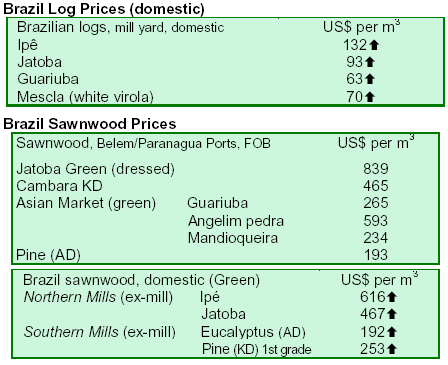
7.
PERU
Finnish investors to identify investment opportunities
in Peru
The Commercial Section of Finnish Embassy in Lima, Peru, said that Finnish investors are willing
to invest in the forestry, mining and energy sectors of Peru. Next year, a mission will be sent to
Peru to identify investment opportunities. Nevertheless, the Embassy reported that
while the forestry sector holds much interest, the country had concerns over land tenure and the size of the
land in Peru available for forest harvesting.
A spokesperson from the Embassy¡¯s commercial section noted that the Finnish government had
started a commercial partnership programme, ¡®Finnpartnership¡¯, which offers opportunities to
develop joint ventures with Finnish companies and/or projects considering Finland
and the EU as main market destinations for products. Finnpartnership will provide funds to support small
companies from ten developing countries to allow them to export their products to Europe. For
Peruvians to benefit from the programme, a Finnish company must express interest in forming a
partnership with a Peruvian community. The maximum amount of funds a Peruvian
community can receive for partnering with the Finnish company is USD726,000. The main idea of the
programme is to facilitate development within the poorest populations by offering job opportunities and technology
improvements.
Peruvian lumber exporters await outcome of talks with Mexico
With the Economic Complementation Agreement (ACE-8) between Peru and Mexico being finalized
this December, Peruvian lumber exporters are on the look out to see where Peruvian and Mexican
governments can meet common ground on Peruvian lumber exports. Mexico is the second
largest destination for Peruvian wood products and first for the Loreto region, which annually exports wood
products valued at approximately USD50 million. These exports largely consist of exports of cedrela
and banack. The negotiations are also focused on incorporating a number of lesser used species
such as congona, machinga and moena, which are currently being exported to the US,
Asian and European markets.
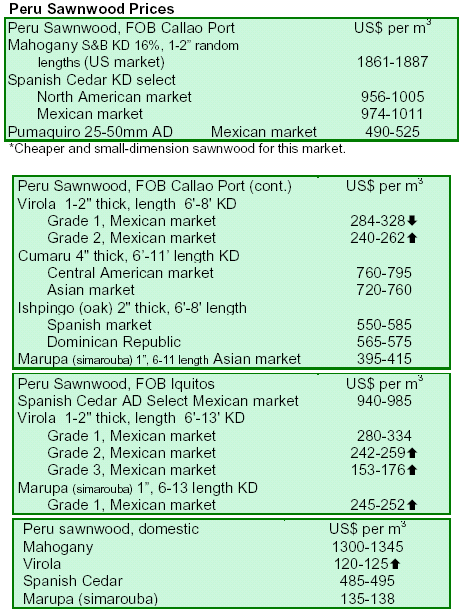
8.
MEXICO
New carbon monitoring tool launched in Mexico
Reforestamos Mexico, the National Forest Institution (INE) and Pronatura Mexico, launched a tool
that will help Mexicans calculate the carbon emissions they generate from their daily activities.
Each person can access the tool via an electronic website and enter relevant data such as
kilometers crossed in public transport or kilowatts of electricity spent to determine actions they can
undertake to reduce the problem of climate change. The site offers suggestions for people to help
reduce the generation of greenhouse gases and can be found at http://www.calculatusemisiones.com.
9.
PANAMA
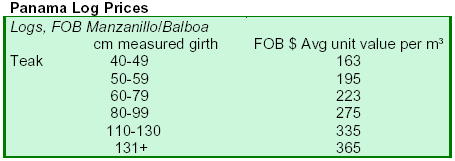
10.
BOLIVIA

11.
GUYANA

|